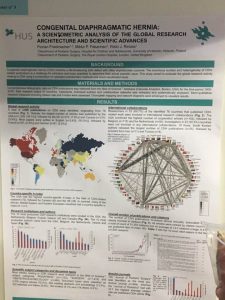Our President, Dawn Ireland, attended the EUPSA meeting in Paris over the summer. One of the posters presented at this European conference for Pediatric Surgeons reported on the research collaboration for CDH. It was interesting and disheartening to see that so much less collaboration is happening in the United States for Congenital Diaphragmatic Hernia in comparison to Europe. Though there are groups that do collaborate such as the CDH Study Group, DHREAMS and the coordinated efforts of Columbia University, Massachusetts General and the University of Utah genetic labs…. there are still substantially less published joint research efforts. Is it because the United States healthcare system is capitalistic and more proprietary and the European system is less competitive? Or is it because of less research funding in the United States?
Regardless, there are barriers in the United States compared to the open research efforts in other countries and until hospitals, doctors and researchers more freely share information and work together to save research resources, we will continue to lag behind our European counterparts and ultimately, it is the patients who are losing.
How can patient families help push for collaboration and more research? Ask your child’s doctor if the hospital is part of the CDH Study Group? DHREAMS? The Global Peds Surgery Network? Who do they co-author with? Do they refer patients to the Global CDH Registry at CDHi? How are they furthering CDH research by working with others? And if they are not working with others, why not?
Patient advocacy is the key to research. In pushing for it, funding it, pressuring the medical community to work together for the good of the patients.
 Shared with permission:
Shared with permission:Dear Mrs Ireland,
It was nice meeting you at the EUPSA conference in Paris last months. Unfortunately, I was not able to attend the BAPS meeting in Liverpool last week.
I was delighted to hear that you think our paper on CDH-related research is important and forms part of the current discussion in this field. We performed this analysis to provide a useful guide for clinicians, scientists and stakeholders to identify latest CDH results. Our study showed that over the past decades, CDH research has progressed from simple empirical observations to accumulation of best clinical evidence, becoming much more multidisciplinary with main research endeavors concentrating in a few high-income countries. Collaborative research has led to substantial progress in prenatal diagnostics and interventions, implementation of standardized neonatal treatment protocols and most recently regenerative medicine therapy. All these advances hold now the promise of improving CDH patient care and outcome in the 21st century.
However, several international multicenter consortiums and national research networks have addressed many critical knowledge gaps pertaining to CDH care. Most importantly, they have identified variability in both CDH practice and outcome among participating centers. Using combined data from these groups, national or international consensus guidelines for multidisciplinary CDH treatment may be produced to standardize best practices for patients with CDH, from prenatal diagnosis to hospital discharge, based on the best available clinical evidence. Therefore, international collaborations and translational research should be strengthened to allow further evolution in this field. In addition, cooperation with global initiatives such as CDH International may help to foster future research activities and reinforce support groups around the world.
I am looking forward to hearing from you.
Kind regards,
Florian
Florian Friedmacher, MD, MSc
Department of Pediatric Surgery
The Royal London Hospital
London
United Kingdom
———————————————————————-
Abstract
Despite a growing interest to clinicians and scientists, there is no comprehensive study that examines the global research activity on congenital diaphragmatic hernia (CDH). A search strategy for the Web of Science™ database was designed to identify scientific CDH publications. Research output of countries, institutions, individual authors, and collaborative networks was analyzed. Semi-qualitative research measures including citation rate and h-index were assessed. Choropleth mapping and network diagrams were employed to visualize results. A total of 3669 publications were found, originating from 76 countries. The largest number was published by the USA (n = 1250), the UK (n = 279), and Canada (n = 215). The USA combined the highest number of cooperation articles (n = 152), followed by Belgium (n = 115) and the Netherlands (n = 93). The most productive collaborative networks were established between UK/Belgium (n = 53), Belgium/Spain (n = 47), and UK/Spain (n = 34). Canadian publications received the highest average citation rate (22.8), whereas the USA had the highest country-specific h-index (72). Eighty-five (2.3%) articles were published by international multicenter consortiums and national research networks. The most productive institutions and authors were based in North America and Europe. Over the past decades, CDH research has increasingly become multidisciplinary and numerous innovative therapeutic strategies were introduced. CDH-related research has constantly been progressing, involving today many disciplines with main research endeavors concentrating in a few high-income countries. Recent advances in prenatal interventions and regenerative medicine therapy hold the promise of improving CDH outcome in the 21st century. International collaborations and translational research should be strengthened to allow further evolution in this field.
https://link.springer.com/article/10.1007%2Fs00383-018-4304-7
 Shared with permission:
Shared with permission:




